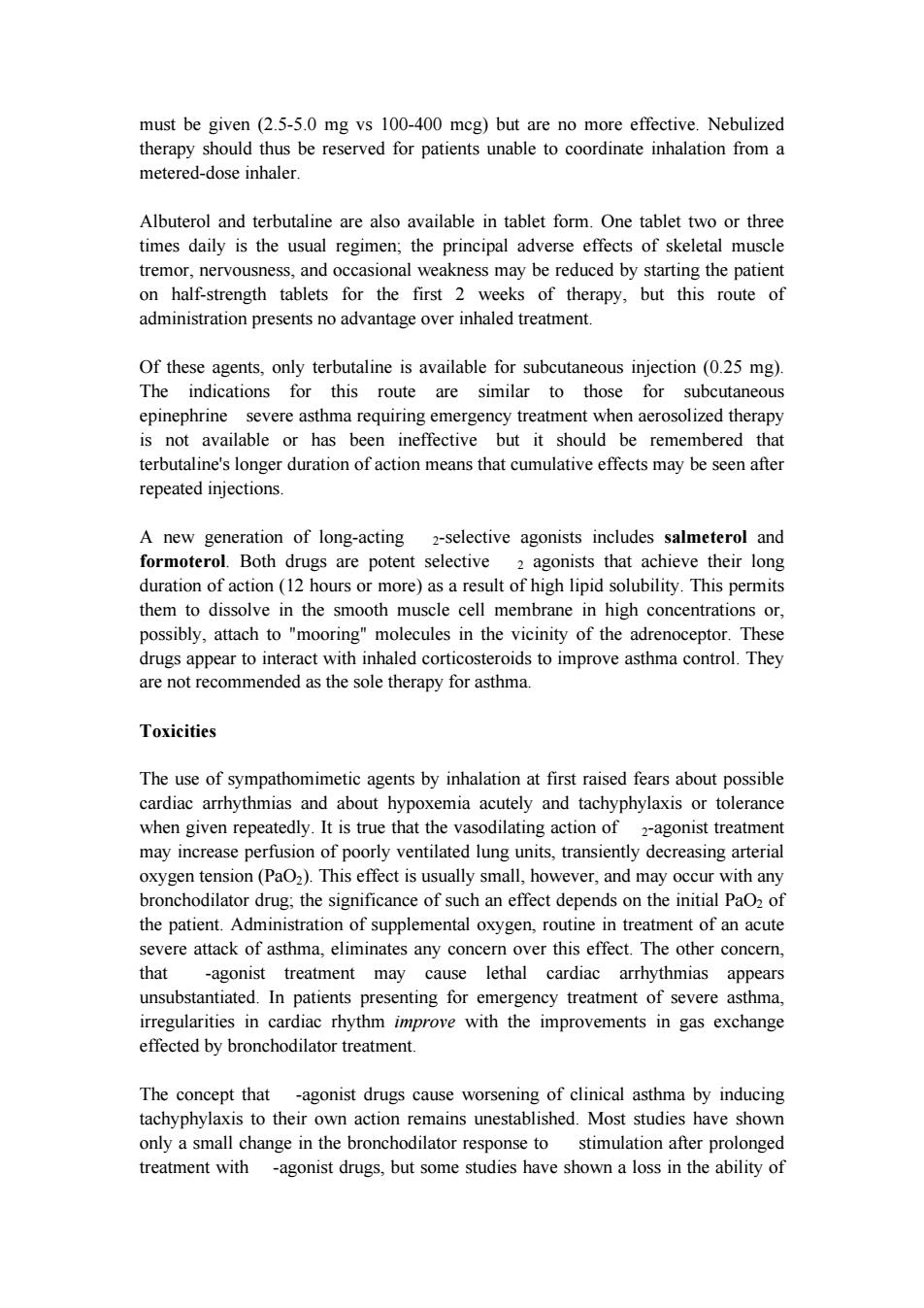正在加载图片...

must be given(2.5-5.0 mg vs 100-400 mcg)but are no more effective.Nebulized therapy should thus be reserved for patients unable to coordinate inhalation from a metered-dose inhaler. Albuterol and terbutaline are also available in tablet form.One tablet two or three times daily is the usual regimen;the principal adverse effects of skeletal muscle tremor,nervousness,and occasional weakness may be reduced by starting the patient on half-strength tablets for the first 2 weeks of therapy,but this route of administration presents no advantage over inhaled treatment. Of these agents,only terbutaline is available for subcutaneous injection (0.25 mg). The indications for this route are similar to those for subcutaneous epinephrine severe asthma requiring emergency treatment when aerosolized therapy is not available or has been ineffective but it should be remembered that terbutaline's longer duration of action means that cumulative effects may be seen after repeated injections. A new generation of long-acting 2-selective agonists includes salmeterol and formoterol.Both drugs are potent selective 2 agonists that achieve their long duration of action(12 hours or more)as a result of high lipid solubility.This permits them to dissolve in the smooth muscle cell membrane in high concentrations or, possibly,attach to "mooring"molecules in the vicinity of the adrenoceptor.These drugs appear to interact with inhaled corticosteroids to improve asthma control.They are not recommended as the sole therapy for asthma. Toxicities The use of sympathomimetic agents by inhalation at first raised fears about possible cardiac arrhythmias and about hypoxemia acutely and tachyphylaxis or tolerance when given repeatedly.It is true that the vasodilating action of 2-agonist treatment may increase perfusion of poorly ventilated lung units,transiently decreasing arterial oxygen tension(PaO2).This effect is usually small,however,and may occur with any bronchodilator drug;the significance of such an effect depends on the initial PaOz of the patient.Administration of supplemental oxygen,routine in treatment of an acute severe attack of asthma,eliminates any concern over this effect.The other concern, that -agonist treatment may cause lethal cardiac arrhythmias appears unsubstantiated.In patients presenting for emergency treatment of severe asthma, irregularities in cardiac rhythm improve with the improvements in gas exchange effected by bronchodilator treatment. The concept that -agonist drugs cause worsening of clinical asthma by inducing tachyphylaxis to their own action remains unestablished.Most studies have shown only a small change in the bronchodilator response to stimulation after prolonged treatment with -agonist drugs,but some studies have shown a loss in the ability ofmust be given (2.5-5.0 mg vs 100-400 mcg) but are no more effective. Nebulized therapy should thus be reserved for patients unable to coordinate inhalation from a metered-dose inhaler. Albuterol and terbutaline are also available in tablet form. One tablet two or three times daily is the usual regimen; the principal adverse effects of skeletal muscle tremor, nervousness, and occasional weakness may be reduced by starting the patient on half-strength tablets for the first 2 weeks of therapy, but this route of administration presents no advantage over inhaled treatment. Of these agents, only terbutaline is available for subcutaneous injection (0.25 mg). The indications for this route are similar to those for subcutaneous epinephrine severe asthma requiring emergency treatment when aerosolized therapy is not available or has been ineffective but it should be remembered that terbutaline's longer duration of action means that cumulative effects may be seen after repeated injections. A new generation of long-acting 2-selective agonists includes salmeterol and formoterol. Both drugs are potent selective 2 agonists that achieve their long duration of action (12 hours or more) as a result of high lipid solubility. This permits them to dissolve in the smooth muscle cell membrane in high concentrations or, possibly, attach to "mooring" molecules in the vicinity of the adrenoceptor. These drugs appear to interact with inhaled corticosteroids to improve asthma control. They are not recommended as the sole therapy for asthma. Toxicities The use of sympathomimetic agents by inhalation at first raised fears about possible cardiac arrhythmias and about hypoxemia acutely and tachyphylaxis or tolerance when given repeatedly. It is true that the vasodilating action of 2-agonist treatment may increase perfusion of poorly ventilated lung units, transiently decreasing arterial oxygen tension (PaO2). This effect is usually small, however, and may occur with any bronchodilator drug; the significance of such an effect depends on the initial PaO2 of the patient. Administration of supplemental oxygen, routine in treatment of an acute severe attack of asthma, eliminates any concern over this effect. The other concern, that -agonist treatment may cause lethal cardiac arrhythmias appears unsubstantiated. In patients presenting for emergency treatment of severe asthma, irregularities in cardiac rhythm improve with the improvements in gas exchange effected by bronchodilator treatment. The concept that -agonist drugs cause worsening of clinical asthma by inducing tachyphylaxis to their own action remains unestablished. Most studies have shown only a small change in the bronchodilator response to stimulation after prolonged treatment with -agonist drugs, but some studies have shown a loss in the ability of